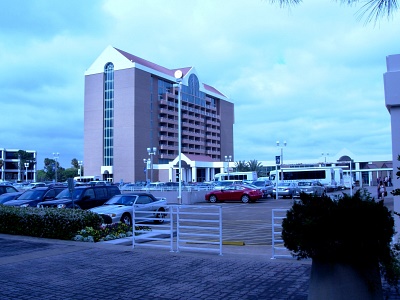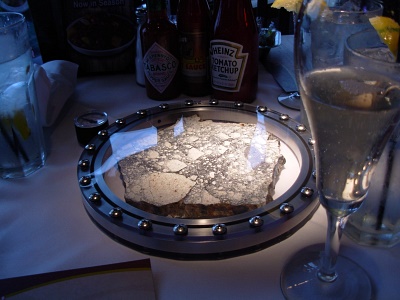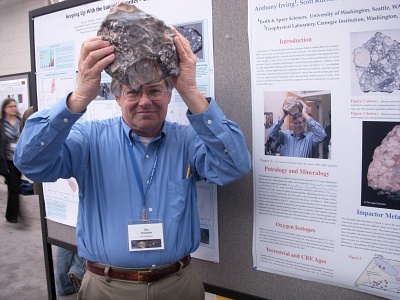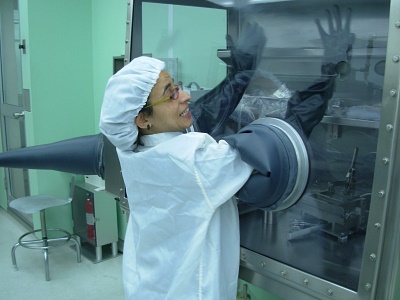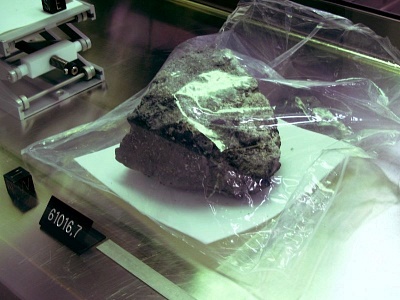IMCA Insights – April 2008
39th Lunar and Planetary Science Conference
by Adam Hupe
I thought this would be a good forum to share my non-scientific perspective of the recent Lunar and Planetary Science Conference. Although many call it the Houston conference, it is actually about 40 minutes away in beautiful League City. The conference itself is held at the plush South Shore Harbour Resort located on Clear Lake and surrounded by marinas and yachts. Over 1,500 scientists attended this year’s event, probably representing the most concentrated amount of brain power on the planet during the week of March 10th to the 14th.
The South Shore Harbour Resort where Conference was held
Overall, I had an outstanding time. The only thing that tempered my enjoyment was observing the scientific community mourning the loss of their fellow friend and colleague, Dr. Gordon McKay, who passed away suddenly shortly before the conference. Some were at his favorite watering hole, Boondoggles, on Sunday night remembering their departed but not forgotten friend over a few beers. They left a chair vacant at their table out of respect for him, while discussing his many accomplishments and how enjoyable he was to be around. Although they managed a few smiles and laughs, I could clearly see that they really missed his presence. I was introduced to him by the very sociable Dr. Everett Gibson four years ago at the only other LPS conference I have ever attended. I found both Dr. Gordon McKay and his brother, Dr. David McKay to be especially approachable and friendly.
On Monday night, Dr. Tony Irving and I were treated to a dinner and champagne by Dr. Douglas Rumble of the Carnegie Institution in celebration of Northwest Africa 5000. We went to a great seafood restaurant called Landry’s on the waterfront at Kemah. This was a kind gesture on his part, as we had all been so busy that there was no time to stop and smell the roses until then. Dr. Rumble is one of the most enthusiastic scientists I have been privileged to meet, a true gentleman in every sense of the word. Perfect food and conversations about meteoritic treasure made for a most pleasant experience.
Lunar Meteorite Northwest Africa 5000 with Champagne on the ready
It took me a few days to get into the swing of the conference as I was suffering from a three hour time difference due to daylight savings and time zone differences. I am not a morning person to begin with so a lot of coffee was necessary to get my mind cranking. Even so, I could only comprehend about 60% of what I heard at the many presentations given in the way of talks. Among the hot topics were the Stardust, Genesis and Messenger Mission results. Of course the Lunar and Martian meteorite presentations are always a primary focus, with attendees occupying the overflow rooms listening to monitors. Brachinites were in favor due to the oddball and paired rocks found in Antarctica named Graves Nunataks 06128/9. The Angrites continue to be a source of keen interest partly because of the presentation given by Dr. Ben Weiss of MIT, whose magnetism study results clearly show that the Angrite parent body had an iron core and probably is (or was) a large planet. I was especially impressed with some of the young scientists whose presentations were well done. I could see them collaborating with some of the patriarchs of modern meteoritics in corners and hallways. I am comforted by the feeling that the future of meteoritic science will be in good hands, as their interest is intense. It was especially entertaining putting faces to the Who’s Who of meteoritics. People rarely look like what you would imagine.
My main reason for attending this year was to promote the I.M.C.A and to present Northwest Africa 5000 by way of a poster session. About 10% of the entire I.M.C.A. membership consists of scientists of one sort or another, so this was a good place to discuss current affairs. Poster sessions consist of hundreds of printed, well-illustrated posters attached to bulletin boards where patrons walk around, ask questions and share knowledge. Dr. Tony Irving prepared several posters but could not man them all, so I was given the opportunity to talk about my favorite stone for hours. This is the first time I have ever talked at one of these sessions, and I was glad to have friendly neighbors who could bail me out if I got in too deep. Dr. Randy Korotev was on one side presenting all of the new lunar finds and Dr. Katie Joy was on the other presenting new data on Northeast Africa 001. I found both of them to be great people and incredibly enthusiastic about my much loved subject. Dr. Don Brownlee, the Principal Scientist on the Stardust mission, stopped by the poster and this provided a great opportunity for another photo session. Dr. Brownlee was one of the first to see Northwest Africa 5000, and the image of him holding it over his head in triumph was circulated around NASA and JPL for weeks.
Dr. Brownlee holding Northwest Africa 5000 Replica in front of poster
One of the greatest highlights for me was the invitation by Dr. Charles (Chuck) Meyer of NASA to tour the Lyndon B. Johnson Space Center facilities. We set up a meeting place at the conference the next day, where he provided me with an official visitor’s badge and transportation to the well guarded base of operations. I thought this trip would consist of looking at the laboratories through glass and was pleased to find out I would actually get a behind the scenes tour instead.
On the way to his office, I was delighted to see familiar poster sized images attached to the walls in the main hallway. One was an image my brother, Greg, took while observing nomads collecting pieces of the NWA 1110 Martian meteorite in the field with crude implements like a window screen and a motorcycle fender. The soil was red and Martian-like. Maybe this is why NASA could relate to the image. Possibly, one day, they will have comparable images of geologists collecting samples on the surface of Mars (using more high-tech tools of course). The other image was a larger than life scan of the cut main mass face of Northwest Africa 5000 taken by Jeff Krosschell immediately after the stone was cut. I asked about this and was told that this stone is now one of Dr. Meyer’s all-time favorites. It was at this moment that I realized that NASA is truly sample oriented. They seem not to care much about where a meteorite was found, but what planetary body it originated from and what can be learned. I was really impressed, as I think the same way.
The Antarctic laboratory was about to be accessed so I was invited to join a group of scientists entering. I immediately recognized Dr. Vera Fernandes in the suit up room. She is one of the fortunate hunters of Antarctic meteorites. I met her a few years back at my small abode on the beach while going through a 2,000 pound load of meteorites brought back from Northwest Africa. She was in town visiting Dr. Irving so I invited them both to help me go through the treasure. I think she was bowled over a little bit by my methods, which differ completely from the way meteorites from Antarctica are treated. I had hundreds of pounds of them soaking in distilled water in five gallon buckets to remove caliche and dirt so that we could get a better look. I would then wipe them off and put them in the oven. She laughed at me for baking them until she saw it was set at 140 degrees. She was thinking Celsius instead of Fahrenheit and was afraid they were being degassed since she is an expert on argon isotope dating. Once her fears were calmed, she hunted through them with gusto. I found out later that these were the first meteorites she was allowed to touch with her bare hands. I only mention this because the Antarctic laboratory is a clean room where one needs to be attired in a bunny suit and be dust-free before entering.
Image of Dr. Fernandes in the Antarctic Laboratory
After being decontaminated, we entered the laboratory, and I was impressed by how sterile everything was -- very unlike the way most dealers handle meteorites. One of the first things I was shown was a freezer full of bagged meteorites waiting to be studied. A few chondrites were in the glove-box chambers and I was able to take a fairly good look at them. I could clearly see chondrules in some of them through the broken surfaces. I was shown the chamber where the ALH 84001 work was performed, and it was at this point that a sense of history struck me. I wandered away from the rest of the group and saw a stone lying out in the open under a Nikon microscope. I recognized it as being the GRA 06128 meteorite everybody was talking about. I immediately grabbed for my camera, set it in macro mode and snapped a few shots. I couldn’t believe my luck. Upon first hearing about this stone, I thought they were making too much of it, even when oxygen isotope testing placed it with the Brachinites. I admit now that the excitement was warranted as its appearance reminded me of a Martian stone. The patchy and shiny crust is similar to that of the Northwest Africa 998 Nakhlite and the matrix is unlike anything I have observed before. I was pulled away from the rest of the group and thought to myself, after such a great encounter, that the visit was over.
Image I took of the Antarctic Achondrite Find GRA 06128
But I was told to suit up again in another room where the sterilization protocol was much stricter than the first. It was at this point I realized that we would be entering the inner sanctum of the lunar laboratory. This was a dream come true for me because I consider the Apollo returned moon rocks to be America’s greatest treasure, more so than all of the gold stored in Fort Knox. I asked if a camera could be brought in and was told yes, but only after it was decontaminated. They would pass it to me later through a special port built into the area for distributing tools. I was advised that no gold could enter the laboratory, so all jewelry had to be removed before the sterilization process began. I went through a few chambers that completely exchange air and remove dust, and then finally I was in. Dr. Chuck Meyer and I had the laboratory to ourselves for about 30 minutes. He was very patient about answering my many questions on how the laboratory operated. I was surrounded by gleaming stainless steel and glass. At one end of the laboratory was the vault used to store these precious jewels from the moon. I was told that once a moon rock left this safe and was worked on, it would be put in a completely different safe, so as to keep the untouched samples pristine.
Image of me in the NASA Lunar Preparation Laboratory
We then walked around the rest of the area where I observed a band saw in a nitrogen filled chamber used to cut this precious space cargo. This was of particular interest to me, as I cut meteorites all the time and was curious about what technology NASA used. We then made our way over to a few lunar samples stored in a nitrogen filled glove-box chamber. I was taken back a little bit by observing that specimen number 61016 was out. This is the largest sample returned by the Apollo missions, and also is known as the “Big Muley”, named in honor of Dr. Bill Muehlberger, the lead geologist on the Apollo 16 team. I recently read about this rock, since I was told that Northwest Africa 5000 is bigger. This may be true now, but the Big Muley used to weigh a hefty 11.7 kilograms at one time, beating Northwest Africa 5000 by a few hundred grams. It has since been considerably reduced in size due to study. Nonetheless, I was still in wonderment over the piece because its history is so rich.
Image of the Lunar Rock "Big Muley", an Apollo 16 Return Sample
I saw too much to convey into simple words that day and I am still somewhat giddy over the experience. I can not thank Dr. Chuck Meyer enough for spending half a day entertaining me with the tour and his encyclopedic knowledge of space history. He good-naturedly answered my many questions and gave me encouragement to keep pursuing riches from space. He truly has the right outlook towards lunar samples, whether they came from an Apollo Mission, Luna Mission or were found as meteorites. His comprehension of Mars meteorites is just as intense, as many of you probably know from reading the Mars Meteorite Compendium.
Upon returning to the conference, I had the opportunity to talk to many researchers about present affairs. I was concerned about the relationship balance between scientists, collectors and dealers. There are still a few who believe all meteorites should be locked behind glass in institutions but they are now in the minority. Most scientists appreciate the opportunity to study samples from the hot deserts and are excited to do so. Their hunt begins in the laboratory where treasure is found at a microscopic level. They are equally excited about samples showing up as we are about learning the results they produce.
A conversation with Dr. Harold Connolly, the former editor of the Meteoritical Bulletin was embossed on my mind. He was among the first scientists to reach out to the collector community by joining the I.M.C.A. and doing a talk at the Tucson Gem and Mineral Show a few years back. I was impressed with his heartfelt openness and sincerity. He has done a lot to improve relationships by bridging the gap with collaboration rather than contempt. He recognized very early that the I.M.C.A. plays an important role in adding much needed professionalism and accountability to meteoritics. He reassured me that relationships have improved dramatically in the past few years and that the gap will become almost unperceivable in the future as attitudes change. I was left very optimistic by this talk.
The earlier days of the “Wild West” and the free-for-all attitudes are coming to a close. It seems that nobody I talked to was interested in the lack of professionalism that haunted meteorite dealing during the gold rush years which are now largely over. The future looks bright with increasing attention given to all sectors. As a matter of fact, the interest is so intense that they may have to relocate the Lunar and Planetary Science Conference to a bigger venue next year.
Happy Collecting!
•
IMCA Home Page •
IMCA Code of Ethics •
IMCA Member List
•
Join IMCA •
IMCA Meteorite Info
